
App Store Optimization (ASO) Checklist for iOS
Faced with the fierce competition on the App Store, you want to optimize your app to stand out from the competition but don’t know where to start. We’ve got you covered! We’ve put together an App Store Optimization (ASO) checklist for iOS to help you get started and boost your impressions and downloads on the App Store.
1. Optimize app title with generic keywords
The title of many apps is simply their brand name. Yet, the app title is indexed by Apple and is the text field with the most weight in the algorithm’s eyes.
- Adding one or two high search volume keywords after your brand name to describe what your app does can help boost your app’s visibility.
With the title on the App Store being limited to 30 characters, saving space is essential.
- Replace traditional dashes (-) by colons (:) and “and” by ampersands (&).
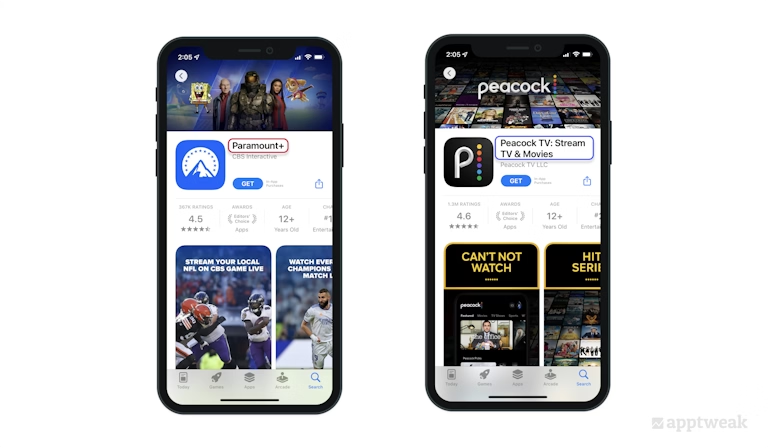
2. Communicate your app’s purpose with the subtitle
Having the same length as the App Store title (30 characters long), your app’s subtitle is indexed as well but given less weight by Apple’s algorithm.
- A good subtitle should convey in a sentence the purpose of your app, while including high search volume keywords.
- Keep your most important keywords at the beginning, so they don’t get cut off on smaller devices.
- Avoid using general terms like “most popular game” or “social networking” in your subtitle. These don’t effectively communicate what sets your app apart or its specific features to potential users.
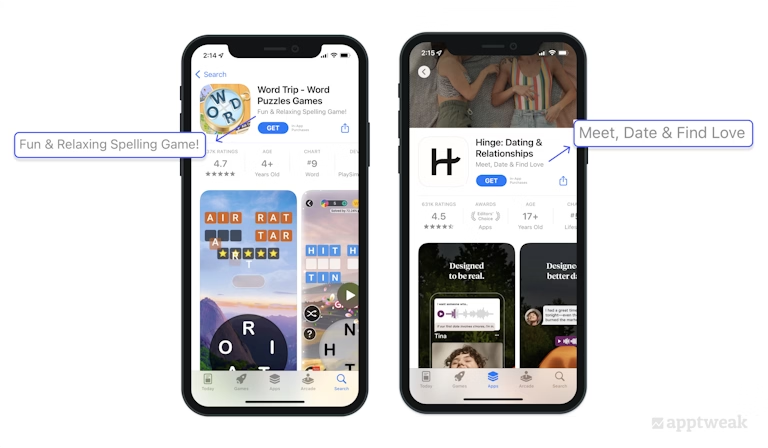
Expert Tip
Don’t repeat keywords in your metadata. On iOS, repeating keywords doesn’t give them more weight.3. Add misspelled keywords in your keyword field
When you do your keyword research on the App Store, you’ll quickly realize that incorrect spellings of certain keywords have more search volume than the correct ones.
- The keyword field, hidden on your app’s page, helps the App Store to understand what your app is about and which keywords it should rank your app for.
- The keyword field is limited to 100 characters, so use this space wisely by following best practices for keyword selection. This improves your app’s visibility and relevance in the App Store.
- The keyword field has the same weight as the subtitle.
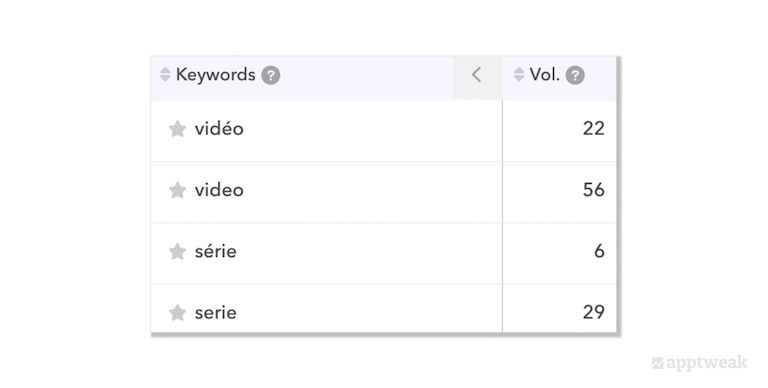
4. Give time to the algorithm to measure keyword performance
If you’ve updated your metadata with new keywords, be patient. Apple’s algorithm needs time to measure the performance of these keywords for your app.
- We recommend waiting for 4 weeks before analyzing the performance of your new keywords, as the metrics are still susceptible to change during the period.
Find out how often you should update your metadata
5. Win store visitors over with your app description
Though not indexed, your app’s description on iOS can prove useful to win over store visitors that are close to conversion.
The app description is likely read by a minority of store visitors who are looking for additional information and arguments to install the app.
- Use your app description to present your app’s value proposition, popular features, multiple use cases, and benefits
- To find inspiration, check which questions are most frequently asked by your store visitors and answer them in the description field
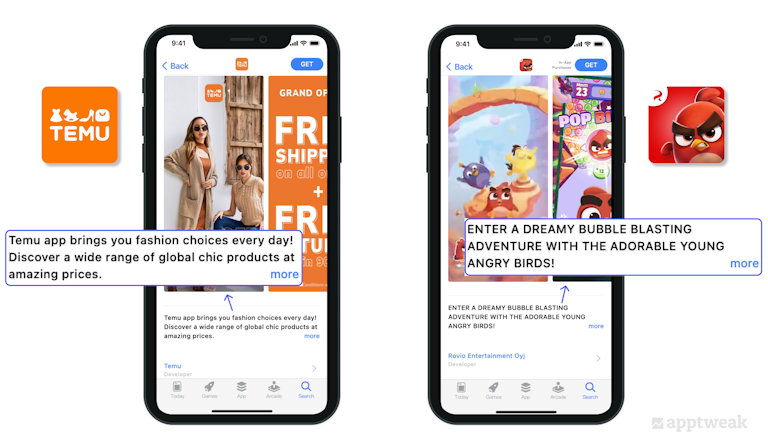
6. Tell a story in the “What’s New” section
Though not indexed, the “What’s New” section can play an important role in keeping users interested and engaged in your app. Instead of writing a bullet point list with the different bug fixes you made (which can give a negative impression of the app):
- Use the “What’s New” section to present new features and improvements
- Add a bit of storytelling to seal the deal
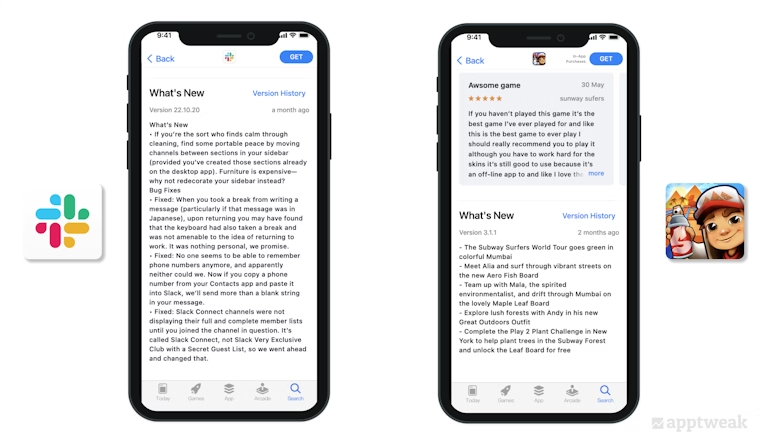
7. Build trust with your developer name
Visitors who consider installing your app want to know if it’s a legitimate one.
So it’s important to have your brand name as the developer name rather than a personal account name, which can reduce your credibility. It also helps you build brand recognition.
8. Create an icon that portrays your app’s function
Your app icon is your brand’s image, and it will be visible wherever your app appears on the App Store.
- Keep your app icon simple and ensure it stands out from other apps
- The icon should speak for itself and convey the purpose of your app
- Make sure your app icon is consistent with the visual identity of your brand
Have a look at these 10 expert tips to design an optimized app icon
9. Catch user attention with screenshots
While it’s important that your screenshots showcase your app experience, they should also be considered as banner ads – ways to encourage your store visitors to download your app.
- Make your screenshots visually striking and self-explanatory to help convert store visitors.
- We also suggest adding short captions in a large font while avoiding explicit call-to-actions. Remember that your first few screenshots are the most visible and, therefore, need extra attention.
- On the App Store, generally, the first three screenshots of an app appear prominently in search results. However, after iOS 15, screenshots no longer display in the App Store search results for apps already downloaded by the user. However, any in-app event card you’re currently running will show, even if the app has already been downloaded. Thanks to this, in-app events present a great opportunity to grab the attention of your users and encourage them to revisit your app.
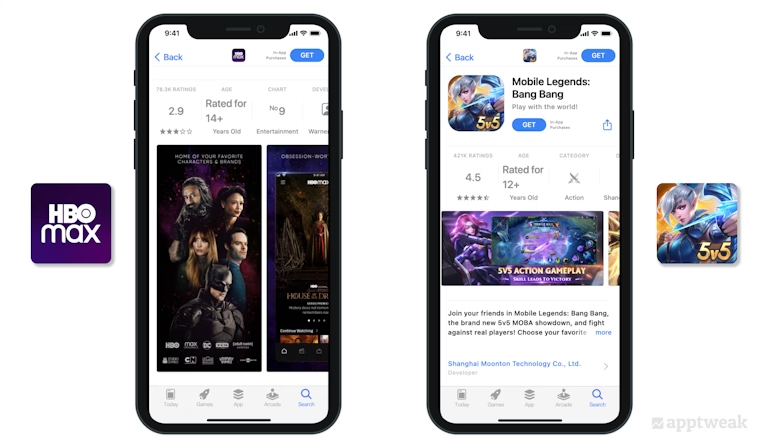
Design the best app screenshots with these expert tips
10. Connect app screenshots to make them engaging
On the App Store, when the screenshots of your app are in portrait mode, the first 3 ones show up in the search results.
- Optimize your first few app screenshots by linking them together through graphic elements. This helps create continuity and storytelling and makes the screenshots more appealing and engaging.
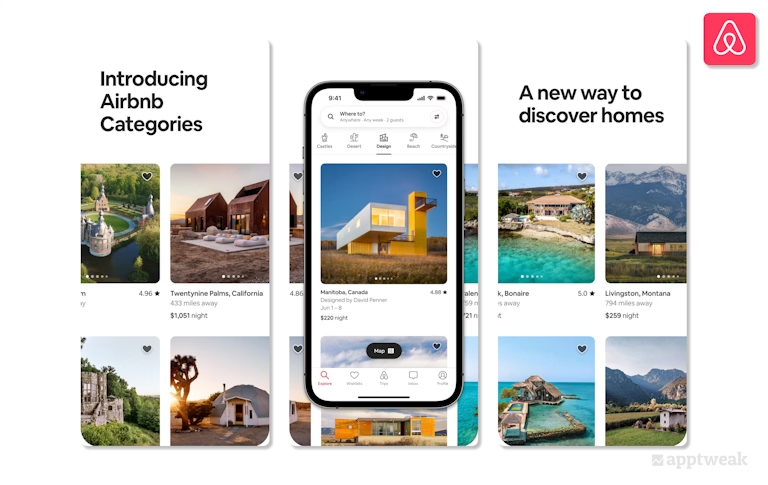
11. Optimize app screenshots for dark mode
A vast majority of store visitors use dark mode on their phones.
However, the dark mode can fundamentally change the appearance of your screenshots.
- Use a color code in your screenshots that works with both light and dark mode.
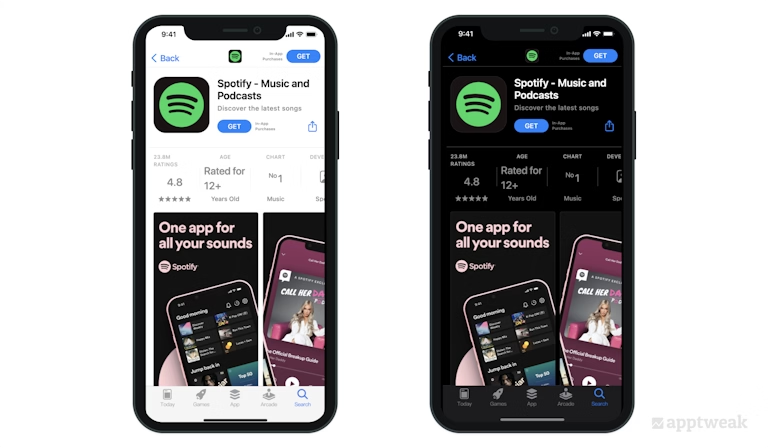
12. Leverage the first 10 seconds of your preview video
Store visitors are nowadays drowned in video – they only spend a few seconds to watch your video that took time to make.
- Aim for quality. Since the first 10 seconds are the most watched, use this time frame to display your app’s most important message and features.
13. Add captions to your app’s preview video
The preview video autoplays on the App Store and is automatically on mute.
-
Use short captions that stay for a while on the screen, clearly delivering your message to visitors. Like screenshots, add large fonts in your preview videos.
14. Adapt creatives to your market
People enjoy content more in their native language.
- Translate your app metadata and adjust your visuals and messaging to match the culture of your target markets. This shows you care and understand them, making visitors feel welcome and confident about your app.
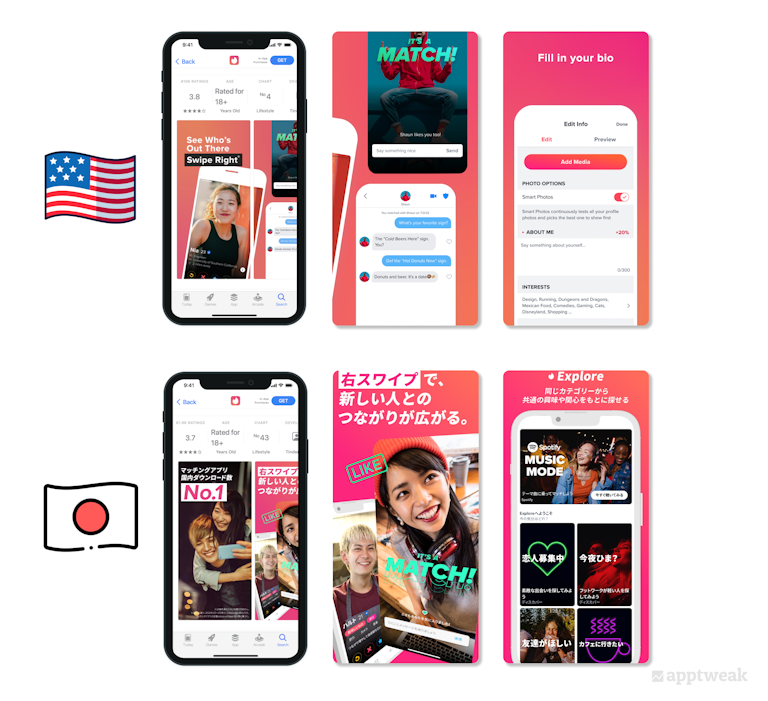
Learn the benefits and examples of cross-localization on the App Store
15. Align your app creatives to seasonal events
With festivities and events like Valentine’s Day, Black Friday, Halloween, and many more, the holiday season is that time of the year when there’s an influx of store visitors with specific interests.
It’s up to you to match those interests and stand out from the competition.
Make the extra effort to update your app creatives to match the event in question and indicate that you may have what users are looking for.
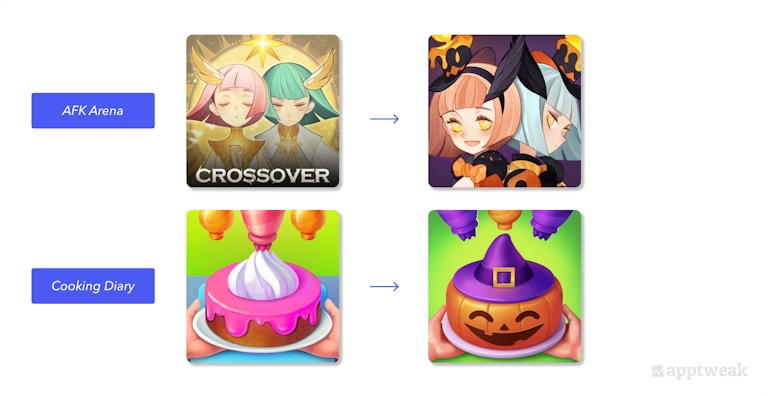
Leverage app store seasonality with these valuable tips & insights
16. Promote content with in-app events
In-app events serve a three-fold purpose:
- help attract new users
- keep current users engaged
- bring back those who haven’t used the app in a while
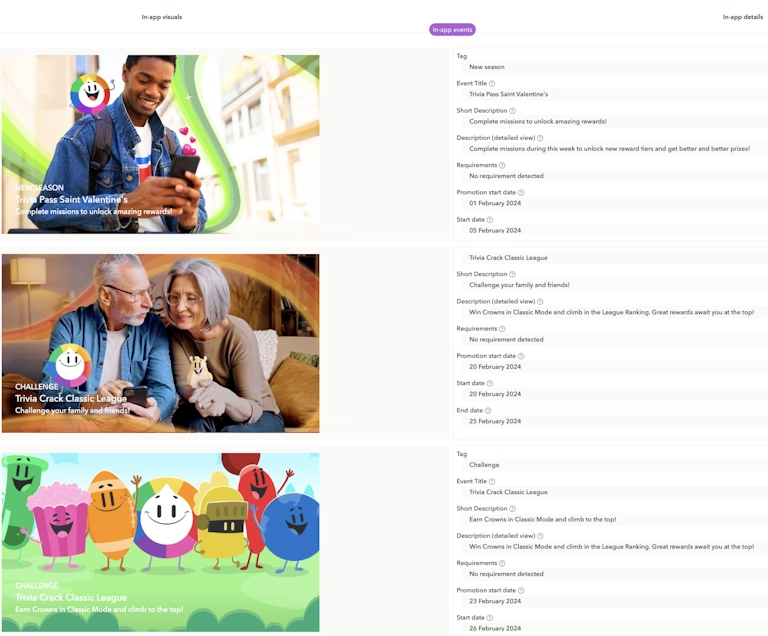
Apple introduced the following in-app event badges to help marketers highlight special activities or occasions within their app/game:
- Challenge: Activities encouraging the user to achieve a goal before the event ends
- Competition: Users compete against one another for the highest ranking or to win rewards
- Live event: Occurs in real-time that all users can experience simultaneously
- Major update: Introducing significant new features, content, or experiences
- New season: Adding new content, storylines, battle pass, or media libraries to build on established content
- Premiere: Announcing new content or media for the first time
- Special event: Limited-time events such as a collaborative event
Expert Tip
At AppTweak, we recommend tailoring your in-app events to specific segments of your audience and targeting different segments with each in-app event.
17. Reply to app reviews
A vast majority of store visitors check reviews and ratings before installing apps.
Review scores aren’t set in stone.
- Take the time to reply to reviews. Showing users you care about their opinion can potentially make store visitors change their mind and even change their negative review score to a positive one.
- Replying to reviews can also assure other store visitors that you are active around product issues.
- If you are short on time, focus on negative reviews first.
18. Set up an in-app ratings prompt
Having good ratings is good, but so is having lots of them.
However, users have a tendency to leave ratings only when they’re unsatisfied with your app. It is important to encourage satisfied users to leave a rating for your app too – hence the importance of implementing a ratings prompt.
-
Choose the best moment to show this in-app ratings prompt, ideally after the user has completed a challenging task and is not busy with something else. For instance, you could display the prompt right after players have conquered a tough level in a game.
19. A/B test creatives to boost conversion
Rather than modifying your creatives on a whim, do it objectively and in a data-driven way with A/B tests.
- A/B testing allows you to test variants of your creatives against the original version to know which one appeals the most to store visitors. Implementing the version they prefer can lead to a positive impact on conversion.
- With A/B testing, you can also monitor the behavior of your incoming traffic. It offers insights into your target market’s preferences, enabling you to optimize your app page for better results.

20. Tailor your messaging with custom product pages
Custom product pages (CPPs) are different versions of an App Store product page that app marketers can set up to showcase various features, content, or deals not found on the default page. Marketers can use these custom pages to target different segments of their audience.
- Use CPPs to tailor your message to your different audience segments. Whereas some may enjoy sales and deals being highlighted, promoting new features might work better on others.
Explore this step-by-step guide to custom product pages

21. Leverage the synergy between ASO & Apple Search Ads
Apple Search Ads can boost your ASO strategy, while a good ASO strategy can make your Apple Search Ads more affordable by reducing the cost per install (CPI).
At the same time, effective Apple Search Ads campaigns can increase your app’s organic visibility, improve conversion rates, and boost keyword rankings.
This creates a cycle, where insights gained from Apple Search Ads can help improve ASO, and thus maximize impact across different channels.
Learn how you can use both Apple Search Ads and ASO to get more downloads
TL;DR
Here’s an essential ASO checklist for optimizing your app for iOS:
- Optimize your app title with generic keywords
- Use your subtitle to describe your app’s functionality
- Use your keyword field space wisely while selecting keywords to improve visibility
- Allow a minimum of 4 weeks for Apple to measure your keyword performance
- Describe your app’s value proposition, features, use cases, & benefits in the description
- Make your “What’s New” section stand out by announcing new features or improvements in a storytelling format
- Have your brand name as the developer name to help build brand recognition
- Create an icon that is simple, stands out, and conveys your app’s purpose
- Design visually striking and self-explanatory screenshots for store visitors. Make sure the captions are short and in a large font.
- Appeal to store users by connecting your app screenshots through graphical elements to highlight storytelling
- Use a color code in your screenshots that works with both light and dark mode
- Leverage the first few seconds of your preview video to display the most important features of your app/game
- Like screenshots, use short captions and large font if you’re using captions for your preview video
- Adapt your app metadata & update your creatives to align with the cultural interests of your target market
- Align your app’s product page with seasonal offerings to indicate that you may have what users are looking for
- Run in-app events on iOS to attract new users, engage current users, and win back lapsed users
- Make sure to reply to app store reviews to show users you care about their opinion. Address negative reviews first.
- Encourage satisfied users to leave a rating for your app with a ratings prompt, but place this prompt at the right moment
- Implement A/B testing to understand the behavior of incoming traffic and improve your marketing efforts
- Use CPPs to display different metadata/visuals from your default product page to get the best results from specific traffic segments coming from other sites or ads.
- Leverage the synergy between ASO and Apple Search Ads to improve your organic visibility, conversion, and keyword rankings



 Micah Motta
Micah Motta

 Chloé Morant
Chloé Morant

 Georgia Shepherd
Georgia Shepherd